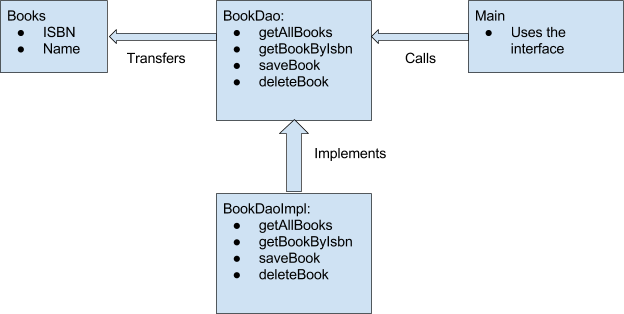DAO stands for Data Access Object. DAO Design Pattern is used to separate the data persistence logic in a separate layer. This way, the service remains completely in dark about how the low-level operations to access the database is done. This is known as the principle of Separation of Logic.
DAO Design Pattern
With DAO design pattern, we have following components on which our design depends:
- The model which is transferred from one layer to the other.
- The interfaces which provides a flexible design.
- The interface implementation which is a concrete implementation of the persistence logic.
Implementing DAO pattern
With above mentioned components, let’s try to implement the DAO pattern. We will use 3 components here:
- The
Bookmodel which is transferred from one layer to the other. - The
BookDaointerface that provides a flexible design and API to implement. BookDaoImplconcrete class that is an implementation of theBookDaointerface.
Let us put this logic into a diagram: 
DAO Pattern model Class
Now, let’s put up our model object.
package com.journaldev.model;
public class Books {
private int isbn;
private String bookName;
public Books() {
}
public Books(int isbn, String bookName) {
this.isbn = isbn;
this.bookName = bookName;
}
// getter setter methods
}
It is a simple object with just 2 properties to keep things simple.
DAO Pattern Interface
Let’s define the interface to access the data associated with it at persistence level.
package com.journaldev.dao;
import com.journaldev.model.Books;
import java.util.List;
public interface BookDao {
List<Books> getAllBooks();
Books getBookByIsbn(int isbn);
void saveBook(Books book);
void deleteBook(Books book);
}
DAO Pattern Implementation
Next, we create a concrete class implementing the above interface.
package com.journaldev.daoimpl;
import com.journaldev.dao.BookDao;
import com.journaldev.model.Books;
import java.util.ArrayList;
import java.util.List;
public class BookDaoImpl implements BookDao {
//list is working as a database
private List<Books> books;
public BookDaoImpl() {
books = new ArrayList<>();
books.add(new Books(1, "Java"));
books.add(new Books(2, "Python"));
books.add(new Books(3, "Android"));
}
@Override
public List<Books> getAllBooks() {
return books;
}
@Override
public Books getBookByIsbn(int isbn) {
return books.get(isbn);
}
@Override
public void saveBook(Books book) {
books.add(book);
}
@Override
public void deleteBook(Books book) {
books.remove(book);
}
}
Using DAO Pattern
Finally, we put this implementation to use in our main() method:
package com.journaldev;
import com.journaldev.dao.BookDao;
import com.journaldev.daoimpl.BookDaoImpl;
import com.journaldev.model.Books;
public class AccessBook {
public static void main(String[] args) {
BookDao bookDao = new BookDaoImpl();
for (Books book : bookDao.getAllBooks()) {
System.out.println("Book ISBN : " + book.getIsbn());
}
//update student
Books book = bookDao.getAllBooks().get(1);
book.setBookName("Algorithms");
bookDao.saveBook(book);
}
}
Advantages of DAO pattern
There are many advantages for using DAO pattern. Let’s state some of them here:
- While changing a persistence mechanism, service layer doesn’t even have to know where the data comes from. For example, if you’re thinking of shifting from using MySQL to MongoDB, all changes are needed to be done in the DAO layer only.
- DAO pattern emphasis on the low coupling between different components of an application. So, the View layer have no dependency on DAO layer and only Service layer depends on it, even that with the interfaces and not from concrete implementation.
- As the persistence logic is completely separate, it is much easier to write Unit tests for individual components. For example, if you’re using JUnit and Mockito for testing frameworks, it will be easy to mock the individual components of your application.
- As we work with interfaces in DAO pattern, it also emphasizes the style of “work with interfaces instead of implementation” which is an excellent OOPs style of programming.
DAO Pattern Conclusion
In this article, we learned how we can put DAO design pattern to use to emphasize on keeping persistence logic separate and so, our components loosely coupled. Design patterns are just based on a way of programming and so, is language and framework independent. Feel free to leave your views in comments below. Download the DAO example project from below link.
Download DAO Pattern Example Project
References: Oracle Documentation, Wikipedia.
Source:
https://www.digitalocean.com/community/tutorials/dao-design-pattern













